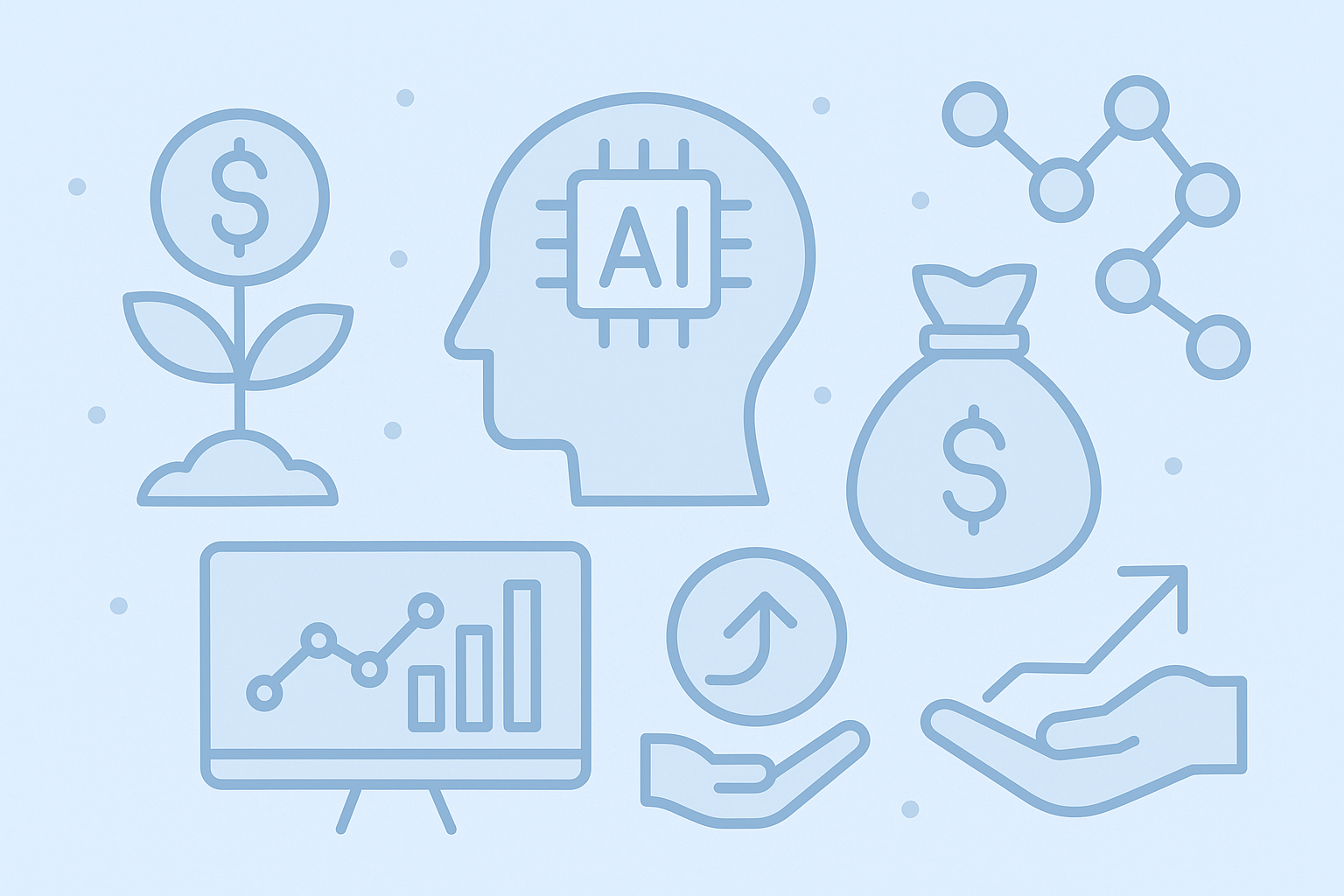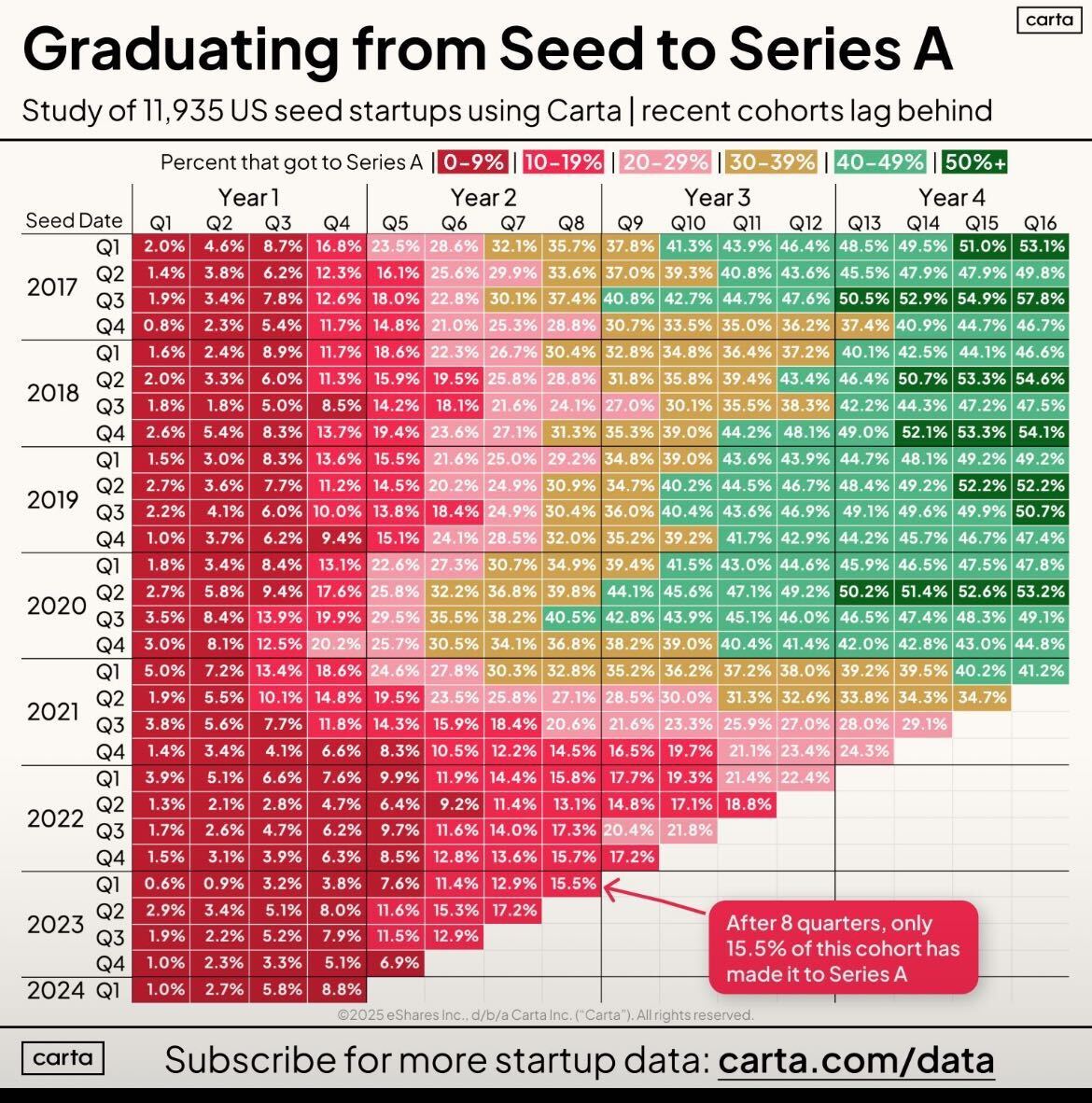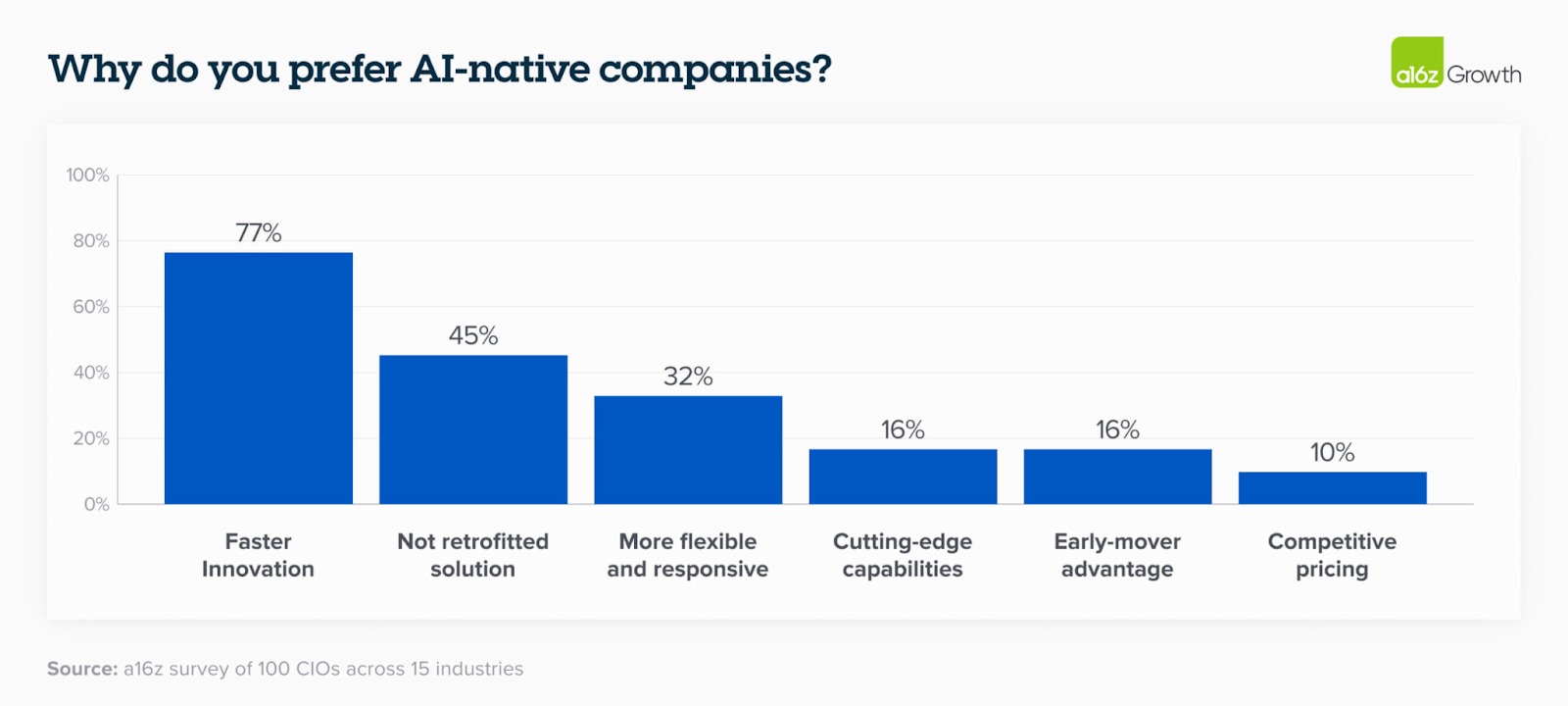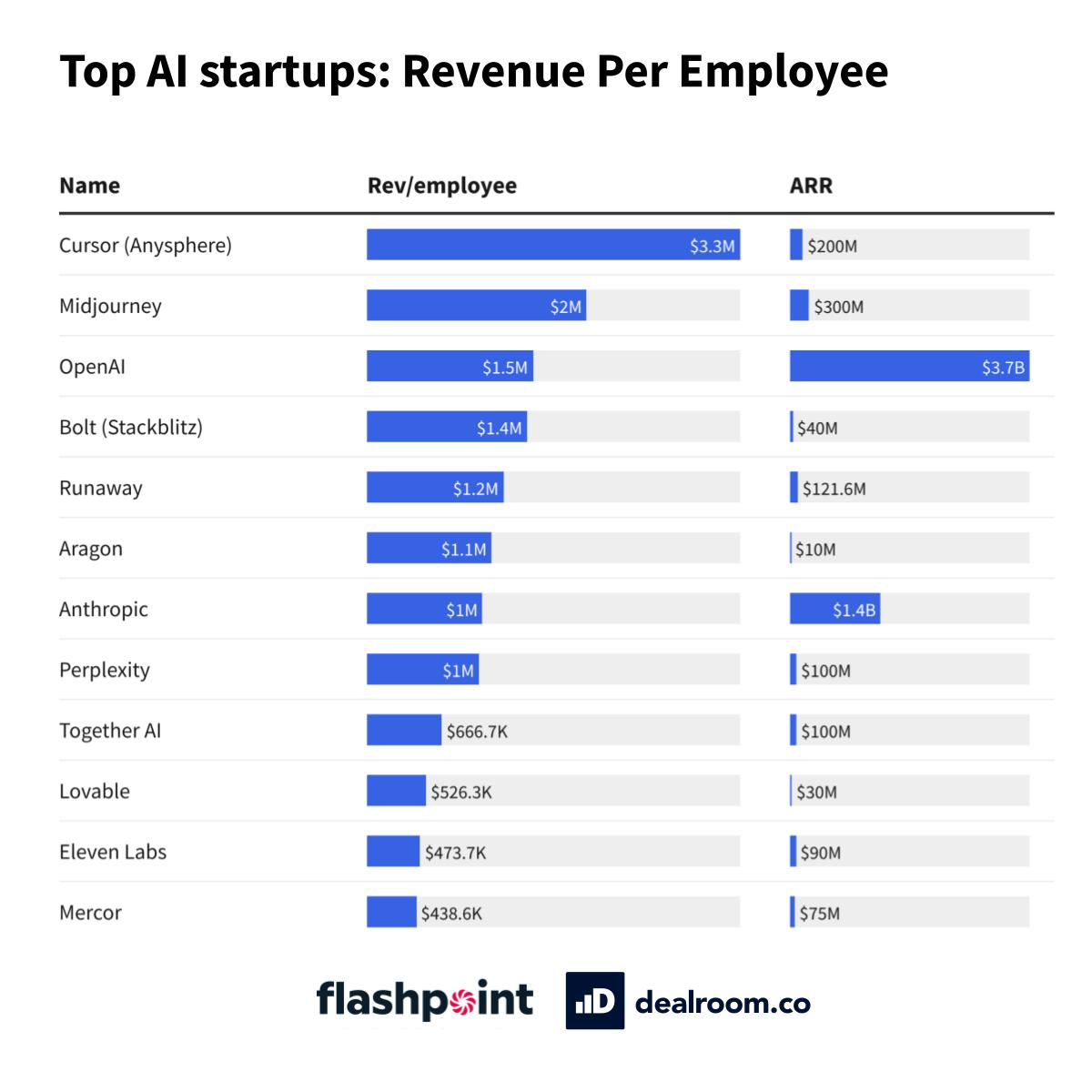 Download Here
Download HereTraditional venture capital models, once almost formulaic, are now faltering. Recent data from Carta reveals a striking trend: only 15.5% of seed-funded startups from Q1 2023 reached Series A within two years – a dramatic drop from the 30-40% rates of 2017 to 2020. We're witnessing a fundamental shift in how early companies scale. The question facing investors, founders, and corporate strategics alike is whether this represents a temporary market correction or signals a new paradigm in startup development, further fueled by the newfound acceleration of foundational model deployment.

A new “seed-strapping” model is emerging. This model represents a hybrid approach between traditional bootstrapping (building a company without taking dilutive capital from external investors) and venture-backed scaling. Unlike the classic model, where startups raise seed funding to quickly prove product-market fit before seeking larger institutional rounds, seed-strapping companies are raising larger seed rounds at higher valuations, building for extended periods, generating revenue more quickly, and strategically delaying their growth raises (if they wind up taking additional money at all). The ability to iterate, build, and experiment at the rates we’re seeing today enables teams to reach profitability much more quickly, decreasing the need for future fundraising.

The Forces Driving This Shift
This isn't simply about bigger seed rounds. It's a fundamentally different approach to company building that leverages four key characteristics:
- Larger seed rounds at higher valuations: AI-native startups are commanding premium valuations at the seed stage because they can demonstrate more substantial progress with less capital than their predecessors.
- Extended development periods between funding rounds: Rather than rushing to Series A, these companies are using their seed capital to build deeper, more defensible products over longer timeframes.
- More substantial proof points before seeking institutional growth capital: By the time these companies approach Series A investors, they often have metrics and traction that would have historically been associated with later-stage companies (i.e., faster time to product maturity, traction, and revenue).
- Pace of velocity never seen before: Teams can experiment and build faster than ever before, thanks to innovations within the development stack (e.g., Claude Code, Cursor). Within sales teams, we’re seeing the emergence of similar trends with them selling faster due to an increased appetite for AI and curiosity from corporate buyers, as well as automation within the GTM stack. This increased efficiency and output are enabling companies to grow faster than ever before, breaking all of the rules on revenue scaling while also changing the bounds of what is possible with seed/early-stage capital
Several converging factors are enabling this new model. AI-accelerated development cycles allow lean teams to achieve what previously required significant investments in engineering headcount. Simultaneously, Series A investors have become increasingly selective, raising the bar for institutional growth capital and creating opportunities for patient seed investors willing to support longer development cycles.
The New Risk Equation
Seed-strapping introduces its own complexities. While teams are leaner and development cycles faster, the larger rounds and extended timelines don't eliminate burn rate concerns. High-caliber AI talent commands premium compensation packages—often rightfully so—creating a dynamic of fewer but more expensive team members. This shift makes team composition and talent evaluation increasingly critical diligence factors for investors.
The model also requires a different perspective on risk. Larger seed investments over longer periods mean more capital at risk before major validation milestones, demanding more sophisticated early-stage evaluation frameworks and ongoing portfolio support.
Industrial Applications: Early Signals of Change
At Blackhorn, we're beginning to observe early indicators of seed-strapping behavior in our portfolio, though we believe this trend is still in its nascent stages, especially for startups serving physical industries. The traditional constraints of industrial innovation still apply: longer development cycles, regulatory complexity, and opaque sales cycles.
However, we hypothesize that industrial seed-strapping is emerging, just on industrial timelines. The early signals are compelling: We're observing several portfolio companies bring products to market and gain enterprise traction quicker than ever before with teams a fraction of the size of what was required even 3 years ago. We’ve seen several portfolio companies successfully launch products and achieve enterprise traction within weeks and months rather than years. This level of efficiency gain isn't just about cost savings—it represents a fundamental shift in how AI-native companies can compete in capital-intensive industries.
We're also seeing faster proof-of-concept development across our portfolio, with AI enabling rapid prototyping and simulation capabilities – Cursor, V0, Lovable, Base44 – that were previously prohibitively expensive or time-consuming. Companies like Thinklabs are demonstrating compelling ROI metrics at the seed stage that compare favorably to what previous generations of industrial startups could achieve only after multiple funding rounds.
Corporate engagement patterns are shifting as well. We're observing increased participation from strategic investors in larger seed rounds, suggesting that corporate decision-makers are recognizing the value of engaging with AI-native startups earlier in their development cycles.

Strategic Implications for Industrial Stakeholders
The seed-strapping model creates new opportunities–and new responsibilities–for industrial corporations. Whereas traditional playbooks encouraged waiting until a company reached Series A maturity, today’s AI-native companies remain in the seed phase longer, reaching major proof points and customer readiness earlier. Engaging these startups at the seed-strapping stage allows corporates to influence product development, achieve critical integrations, and access innovation ahead of competitors. However, acting early raises the stakes: deeper technical and operational diligence, shared risk in pilot programs, and mutual commitment to longer timelines are now essential parts of the partnership equation.
Corporate leaders we speak with are focused on four key areas that align closely with what AI-native industrial startups are building: automation at scale, advanced safety systems, productivity breakthroughs, and competitive positioning in what many describe as an "AI arms race." The convergence of corporate urgency around these priorities with the emergence of capable, AI-native, early-stage startups creates high-leverage opportunities for strategic partnerships. Seed-strapping enables startups to focus on real operational value and integration depth rather than surface metrics often chased for the next fundraising round.
Timing is particularly critical: AI solutions often require deep operational integration to deliver their full value proposition. Engaging with startups during their seed-strapping phase—when they have sufficient capital to invest in partnership development but remain flexible enough to adapt their technology to specific corporate needs—may prove more valuable than waiting for more mature companies with established product roadmaps.
For industrial corporate investors and CVCs, the implication of seed-strapping is a tilt toward larger, longer-duration seed partnerships with fewer “traditional” up-rounds. This shift requires:
- Greater selectivity with deeper technical and commercial diligence upfront
- Revised capital pacing and risk models, with an emphasis on staying actively involved rather than passively tracking milestones
- Ongoing portfolio support, including providing non-financial resources and increased technical expertise during extended seed phases
- Evolving investing frameworks to properly evaluate AI-native industrial startups and their potential for achieving traditional Series A milestones during their longer seed phase
For industrial leaders, seizing the seed-strapping moment means recalibrating risk, deepening relationships, and embracing joint innovation as a core element of strategy.
The Road Ahead:From Skepticism to Experimentation
Industrial seed-strapping represents a paradigm shift for manufacturing and industrial sectors, where AI-native startups are leveraging unprecedented development velocity to address long-standing operational challenges. This approach is gaining traction as C-suite executives—particularly CEOs and COOs—drive increasingly bullish sentiment around AI adoption, motivated by competitive pressures and broader economic headwinds.
The industrial sector is experiencing a notable shift from AI skepticism to active experimentation. While broad adoption remains limited, early case studies demonstrating tangible improvements in equipment uptime and yield optimization are capturing executive attention. However, many organizations struggle with identifying the right initial use cases, creating both opportunity and complexity for solution providers.
Best Practices for Market Entry
Companies targeting manufacturing and industrial buyers should focus on several key strategies:
- ROI-Centric Positioning: Frame solutions around clear business objectives rather than AI capabilities alone. Equipment uptime improvements and yield gains resonate most strongly, while worker productivity and safety enhancements provide additional value drivers.
- Stakeholder Mapping: While C-suite executives drive purchasing enthusiasm, successful implementations require downstream alignment across procurement, IT, finance, and operations teams. Sales strategies should address both the visionary buy-in from leadership and the practical implementation concerns of operational stakeholders.
- Domain Expertise Integration: Success requires deep understanding of regulatory requirements, safety considerations, and complex operational environments. Companies that combine technical AI capabilities with sector-specific knowledge create stronger competitive differentiation.
The Seed-Strapping Advantage
AI-native startups employing seed-strapping methodologies are uniquely positioned to capitalize on this moment. Their ability to deploy and iterate rapidly with fewer resources enables a level of operational velocity previously unseen in industrial spaces. As these solutions become deeply embedded in critical operations, they may create substantial competitive moats through operational dependency and integration complexity.
While adoption across industrial verticals will likely remain gradual due to inherent sector conservatism and safety requirements, companies that successfully navigate this transition period—leveraging seed-strapping to build robust, compliance-ready solutions—are positioned to secure lasting competitive advantages and achieve broader market impact than traditional point solutions.
Preparing for the Shift: How We're Adapting Our Investment Approach
Seed-strapping presents both opportunity and urgency for industrial stakeholders, requiring fundamental changes in how we evaluate and support AI-native startups. At Blackhorn, we're actively evolving our investment framework to match this new paradigm: developing enhanced technical due diligence capabilities for AI-native teams, maintaining flexibility for larger seed commitments with extended runway expectations, and providing active operational support rather than passive milestone tracking. We're also leveraging our corporate LP network to facilitate earlier strategic partnerships, recognizing that the timing of corporate engagement has fundamentally shifted.
The startups defining the next generation of industrial AI are moving at an unprecedented pace—meaning the window for engagement is compressed. Our sector expertise, evolved investment framework, and deep industry relationships position us to identify and support the AI-native startups driving this transformation. As the funding landscape continues to evolve, those who adapt their investment strategies quickly—by engaging earlier, providing deeper operational support, and building more integrated relationships—will shape how industries operate for the next decade.



